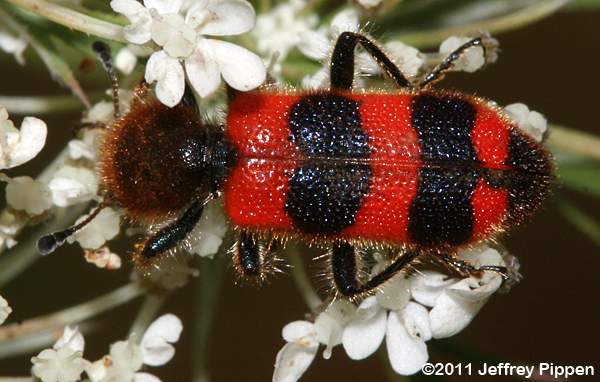Classification
Domain: Eukarya
Organisms within the Domain Eukarya
possess membrane-bound organelles, as well as a true nucleus
containing DNA (Hickman et al. 2009).
Kingdom: Animalia
Trichodes
apivorus belong to this kingdom because they are eukarotic,
motile, heterotrophs, multicellular, and lack cell walls
(Hickman et al. 2009).
Phylum: Arthropoda
All the members of this phylum have
an exoskeleton, segmented bodies, and grow by molting (ecdysis)
(Hickman et al. 2009).
Class: Insecta
Trichodes apivorus is a
member of this class due to the fact that they have compound
eyes, three pair of jointed legs, and a chitonous exoskeleton
(Hickman et al. 2009).
Order: Coleoptera
This particular order is commonly
known as beetles. Trichodes apivorus belong to
this order because they have two sets of wings, specifically the
elytra and the hindwings (Burton 1968).
Suborder: Polyphaga
This is a group distinguished by its
omnivorous members (Burton 1968). Trichodes apivorus'
diet of pollen and bee larvae identifies them as a member of
this suborder (Burton 1968).
Superfamily: Cleroidea
Trichodes apivorus is
included in Cleroidea because the group's main characteristic is
having a slender body, often hairy, and with elytra (Burton
1968).
Family: Cleridae
This family is known as the Checkered
Beetles. Members are highly colorful and often with
intricate designs, cylindrical in shape, hairy, and typically
have larvae that prey upon the larvae of other species (Burton
1968).
Genus: Trichodes
The name "Trichodes" means
"hairy" or "shaggy" in Latin (Dillon 1961). Additionally,
Trichodes are moderately sized, have elongated bodies,
eyes on the anterior of the head, antennae bearing eleven
segments, maxillary (upper jaw) and labial (lips) sense organs,
and are four-segmented (Dillon 1961).
Species: apivorus
Apivorus is latin for the
phrase "bee-eater(Wolcott 1947)." As the adult form is
capable of eating other flower-visiting insects (bees), and the
juvenile stages feed on bee larvae, the name is suitable.
Home Life Cycle and Development >>>